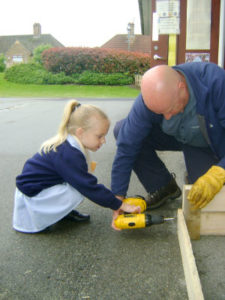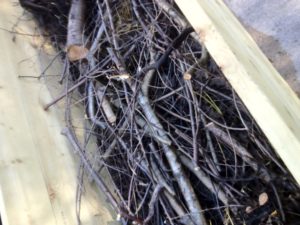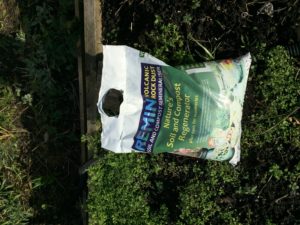The magic of woodchips and earthworms in your vegetable beds
I was prompted to write this article as I have so much information, experiences and photographs, just sitting on my Mac not being of use to anyone! Then I saw this Tweet and read “Agroforestry and using woodchip to improve soil health” in late October and thought, hey I have been doing this for years, having made many scores of raised beds in schools, fire stations, allotments, college grounds, independent hospitals, nursing homes, houses and more. Raised beds with woodchip paths were my signature in places I worked! It absolutely works so why not share my experiences?
Raise the bed don’t dig!
After the initial double-digging, I had to do on my first garden due to the very heavy clay, I have been raised bed no-dig gardening, (earthworms do my digging as in nature!) since the mid-1980s. Besides, digging actually destroys the beneficial mycorrhizal fungi in your soil as well as earthworm channels and even earthworms themselves. It is a myth that if you chop an earthworm in half, you have two earthworms! Alas, it dies. Because of site locations, students, children, etc., I have found it far easier to make and manage wooden beds than have no structure for the bed at all. In many places I have worked, without a structured bed, I would not have been able to grow there. Now I don’t even bother to double dig or even dig unless I am planting a tree or have to remove perennial root systems. So I just raise the beds upwards! My raised beds have evolved over time.
First beds
The first stage was to make simple wooden raised beds and this would involve my students, whether they be school children, adults with mental health issues, or substance issues. Then lay them on the soil or lawn, place newspapers or cardboard and throw well-rotted horse manure inside, topped with soil or garden compost. Pavements and concrete floors were dealt with a little differently in that they had a much deeper bed.
Woodchips for paths
For the paths in between the beds, I preferred to use wood chips being a natural product, cheap and easy to replace. It was this path material that accidentally led me into a form of Hugelkultur. After a year or so the woodchip paths would need replacing. I noticed that underneath the top layer of woodchips was a rich dark brown, moisture-retentive, friable compost full of earthworms. Why waste this useful resource? So into the raised beds, it all went.
Horse manure
The next stage in the development was to fill much deeper raised beds with FRESH wood chips directly, say 2/3 full. Different sized chipping help and mixed with larger pieces of wood all help to stop it settling down and compacting, as sawdust tends to do. Adding horse manure on top of the woodchips helps to provide the nitrogen needed to rot the woodchips as they contain lignin and cellulose. Then topped up well-rotted garden compost, deep enough for most vegetables so as not to deprive them of nitrogen as the wood material rots. This was successful although I realised that compost does not in itself contain the same minerals as soil, so I powdered the compost surface with Rock Dust and dried seaweed. Plants were regularly fed a solution of liquid seaweed.
Birchwood Fire Station Raised Beds
One year I was asked to advise staff at a Cheshire Fire Brigade Station who wished to grow organic vegetables and invite local schools to tend the crops. When I visited I noticed that they had been pruning and cutting the trees surrounding the station. They looked at me as if I was from another planet when I suggested what they could do with their tree trunks, logs, branches, roots and shrubs! You will see the results in the video.
Adding Earthworms
Selective earthworm species were added to the Worm Towers to ‘ignite’ the beds and soon they were teeming with earthworms, making a very productive system. Believe me, this works! It is like having a huge Waste Buster wormery, without the window!
Role of earthworms
Darwin wrote in his book, ‘The Formation of Vegetable Mould’,“It may be doubted whether there are many other animals which have played so important a part in the history of the world, as have these lowly organised creatures.” But why would he say that?
Earthworms are an important part of the soil ecosystem. They mix the organic matter and mineral content of the soils helping the penetration and movement of water, air and nutrients from which plants and soil organisms benefit. They increase microbial activity which facilitates the recycling of nutrients/minerals into forms more readily available to plant roots. Earthworms increase humus in the beds. The raised bed literally becomes a huge wormery full of worm activity which in turn utilises the benefits of a vermicompost enriched soil.
Woodchips
Personally, although more work is needed, I prefer the woodchips method which at this time of the year are easy to obtain as parks, gardens, etc., shred the trees. You often see piles of woodchips just laying there rotting down in parks, so ask the rangers for some to bag up. Or ask a local tree surgeon to drop some off for you. I prefer woodchips as a moisture sump now to adding just garden compost, which tends to dry out quickly. The woodchips have the advantage that being chopped into pieces that are larger than garden compost, they soak up and retain the moisture better. Woodchips under the top layer used as a path are already covered with the essential digesting microbes and may also contain humus by now. They are ideal to recycle and top up the beds which over time will settle down as the materials decompose.
“All my articles and videos, available free, are funded by my teaching and sales of award-winning bumblebee nest boxes, solitary bee boxes, and wormeries. Please help by spreading the word and forwarding this link to your friends and colleagues. https://nurturing-nature.co.uk Thank you” George Pilkington
Tree trunks
Being much larger they take much longer to break down. They are ideal if your allotment, veg growing area, etc., is next to large trees or bushes that need pruning, but transportation to your garden could be an issue. If used I would suggest filling in the gaps as they are loaded into the bed with woodchips and with a layer of horse manure over them. Woodchips provide more areas for the microbes to work on them and increase in population.
Preferred option. Building initial layers
From the ground up, woodchips, 2/3rds of the height, manure/grass/weeds layered on top, remaining height filled with course garden compost, with 3-4 inches of sieved garden compost or sieved woodchip path material, topped off with a mixture of worm compost, leafmould and seaweed with rock dust and initially a few hand full of soil. It can be gently raked into the top surface if about to sow or leave it sprinkled on the surface over winter to find its own way down into the soil. This is ideal for seeds.
So how does this system work?
In simple terms, microbes break down the contents of the raised beds, earthworms do likewise. This action makes minerals available to the plants that they take up we obtain as when we eat them! There is a lot of science involved so let’s unpack it! First, let’s look at what we have.
Minerals in soils
Many of you know the difference between soils and compost. Fresh compost is in the main, depending upon how you make it and what you add, organic matter and living organisms. Soils contain living organisms, organic matter, humus and rock particles. The rock particles contain the mineral elements, such as iron and phosphate. It is known rocks are broken down into smaller particles by several processes, known as direct weathering. Prime examples are water freezing and cracking the rock, (physical weathering), and rock particles dissolving in acidic rainwater, (chemical weathering). Indirect methods of rock breakdown included biological weathering, whereby in moist environments mosses and lichens slowly break down the rock surfaces and acids released by plants or in leaf litter. Using my method we do not have much soil.
Rock Dust
As you will be aware, garden compost/woodchip compost is organic matter and which has been decomposed by microbes, earthworms etc. It may contain trace minerals it absorbed whilst a plant that it acquired from the soil it grew in. As mentioned soil particles contain minerals obtained from rocks. In the absence of soil, as in my raised beds, earthworms will consume rock dust, which is ground down volcanic rock, Soil Association Accredited and from a sustainable source. Being finely ground up dust, they use it to grind up organic matter in their gizzards, (having no teeth!) thereby distributing the rock minerals around the beds in their casts. Rock dust is also added to my Waste Buster wormeries.
Special Offer 5% off Remin by entering nurturingnature into coupon code button then click apply.
Humus
Of course, you could add quality topsoil to your beds and there is no harm in that. Personally I prefer to keep the topsoil where it is found, not have to transport it to my garden and pay for it! Soil is a natural product and may contain humus whereas garden compost is man-made and will eventually contain humus as the compost is broken down and stabilised to a point when the original material is no longer recognisable. I suppose it is the glue that binds the tiny soil particles together whereas sand will simply run through your fingers as its humus content is likely to be low or even nil. Humus retains water and nutrients/minerals and is excreted by earthworms after feeding upon decaying matter.
Role of microbes
Recent research, however, has found another direct weathering of rocks, undertaken by microbes, microbial mineral weathering. Bacteria and fungi have been found to use a variety of mechanisms to release minerals from rocks, which is known as bio-fertilisation. They play an essential role by actively contributing to the release of key mineral nutrients that are not only required for their own nutrition, they are also needed by plants (just like we need minerals!)
Their role in raised beds
Specialist fungi break down the lignin and cellulose in the woodchips and other microbes and bacteria have their part to play. These microscopic soil life organisms are the processors in the soil and earthworms are major facilitators. Microbes are food for earthworms. Yes, earthworms are in effect predators upon soil microbes! Thus earthworms love the woodchips/horse manure mix as well and populations increase. Annual autumn prunings/weeds from my own garden are shredded and go directly into my raised beds.
A fun element for school children!
Kids love exploring and that includes lifting up logs, stones, leaf litter. Get them to hunt for woodlice. By adding woodlice to the raised beds this benefits the whole system as they too break down the material that was one a woodchip path.
Potato no-dig system
Trees, logs, branches, or fresh woodchips, topped with manure, grass/weeds and as above, with the addition of cardboard if growing potatoes, topped with a black woven material to stop light as seen in the video.
Although great inside the beds, I would not advocate a woodchip mulch around plants and this could be a haven for slugs to shelter. Unless of course, you are sure you can correctly use a suitable barrier around your beds to stop them entering. Many are available.
Sowing crops
I do prefer to transplant many of my crops, including onions, peas, beans, which I grow in Rootrainers. I even multi sow radish and spring onions in them and then transplant. Carrots unless they are small round carrots which I no longer grow, are not ideal for transplanting. If you prefer to sow seeds, then season permitting, it is a good idea to plant into the loose friable surface allowing the seed roots to establish themselves before the beds have settled. If not plant wintergreen manures instead of leaving the soil bare and nutrients washing out. As the soil level settles and spring is nearing, lay cardboard or a black woven material over the green manures to kill them then you do not have to disturb the soil microbes as you would if you dig them in. Mustard is easily killed by frosts and is another choice. When ready to sow, peel back the black sun absorbing woven material, as required and simply add some more sieved compost or leafmould on the surface in which to sow.
Special offer
Charles Dowding, who has made a career out of organic Raised Bed No Dig Gardening and is highly regarded in this area, has kindly offered a £1 reduction on his excellent book,’Organic Gardening the Natural No Dig Way’ by using the code nodigbees
Did you know there is actually an Earthworm Society of Britain?
See Vermicompost: a powerful crop nutrient paper
See also Field Lab Report PDF “Peat-free woodchip compost for growing media”.
Mineral weathering by bacteria: ecology, actors and mechanisms PDF
Even the European Union recognises the importance of our soils. They published The European Atlas of Soil Biodiversity which is an absolutely fascinating glimpse into the remarkable yet hidden wildlife living in a hidden ecosystem, (because that is what it is!) which without doubt humans, wildlife and our food depend. Well worth downloading.





Recent Comments